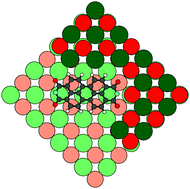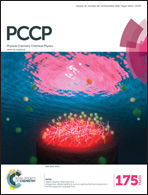Surface induced vibrational modes in the fluorescence spectra of PTCDA adsorbed on the KCl(100) and NaCl(100) surfaces
Abstract
We report a combined experiment-theory study on low energy vibrational modes in fluorescence spectra of perylene-3,4,9,10-tetracarboxylic acid dianhydride (PTCDA) molecules. Using very low coverages, isolated molecules were adsorbed on terrace sites or at sites located at residual steps on (100) oriented alkali halide films (KCl and NaCl). The low energy modes couple to the optical transition only because the PTCDA molecule is geometrically distorted (C2v) upon adsorption on the surface; they would be absent for the parent planar (D2h) PTCDA molecule. The modes differ in number and energy for molecules adsorbed on regular terrace sites and molecules adsorbed at step edge sites. Modes appearing for step edge sites have the character of frustrated rotations. Their coupling to the optical transition is a consequence of the further reduced symmetry of the step edge sites. We find a larger number of vibrational modes on NaCl than on KCl. We explain this by the stronger electrostatic bonding of the PTCDA on NaCl compared to KCl. It causes the optical transition to induce stronger changes in the molecular coordinates, thus leading to larger Franck–Condon factors and thus stronger coupling. Our results demonstrate how optical spectroscopy can be used to gain information on adsorption sites of molecules at low surface concentrations.


 Please wait while we load your content...
Please wait while we load your content...